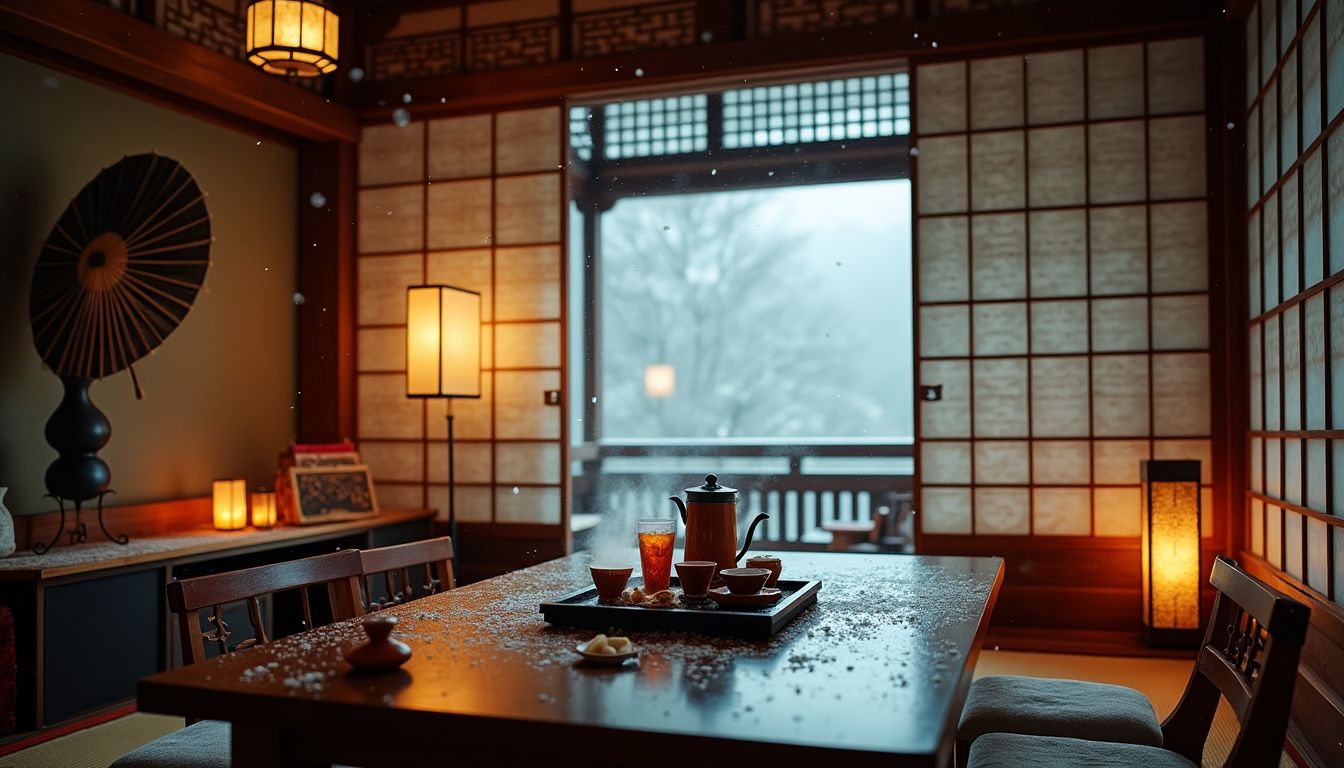The snow fell relentlessly over the ancient city of Kyoto, a fluttering ocean of white that softened the sharp edges of tiled rooftops and twisted cherry trees. The year was 1868, during the final days of the Tokugawa Shogunate’s reign, a time when the old ways fused uneasily with the modern incursions of the West. Through the stillness of the snow-laden streets, a figure walked with quiet purpose, her striking silhouette a dissonant burst of color against the monochrome world.
She was clad in a flowing crimson kimono embroidered with gold threads, the intricate patterns of cranes and chrysanthemums shimmering faintly under the twilight sky. Over this, she wore a black haori jacket with gilded accents at the cuffs and hem, the fabric draped loosely over her shoulders yet tailored enough to accentuate her poised frame. A golden obi cinched her waist, its tied bow forming an elegant cascade of fabric down her back. Snow clung tenaciously to the red fabric of her skirt as she strode forward, but no trace of discomfort marred the calm resolve etched on her face.
Her jet-black hair was pinned into a loose bun adorned with golden kanzashi hairpins, delicate flowers crafted from gold and jade, their tiny petals catching the faint light of the distant lanterns. In her hand, she carried a lacquered black parasol trimmed with crimson cloth, at times using it to shield her delicate features from the fiercer gusts of wind. Her dark eyes, flecked with an almost fire-like intensity, scanned the street with equal parts wariness and purpose.
The city around her hummed with quiet tension. Kyoto, though serene in the falling snow, had become a fractured tableau of old-world elegance and creeping modernization. Samurai patrolled the streets, their blades sheathed but their stances wary. Merchants huddled in their shops, whispering rumors of unrest. A foreign influence lingered, visible in the occasional Western hat atop a passerby or the chime of a clock newly imported from afar. For Yukiko, the woman in crimson, the evolution of Kyoto was not her concern tonight. Her eyes were fixed on her task, a mission as vital as it was dangerous.
Yukiko was no ordinary woman of the era. She was a shinobi—trained in the shadow arts, long thought extinct in this new age of rifles and railroads. Her crimson attire, so ostentatiously bright, marked her as the Scarlet Blade, a myth among those still holding onto the waning hope of the Empire. Word had spread of her exploits, mostly whispered: a woman wreathed in flame-red garments, using deception and guile to strike critical blows in the struggle for Kyoto’s fate. But tonight, her task was of a more personal nature.
She came to a stop before the worn steps of an ancient temple, its torii gate half-buried in snow. The lanterns outside were unlit, an unusual and ominous sign. Tucking the parasol under her arm, she placed her hand on the hilt of the short blade hidden beneath her haori. She felt the familiar weight of her weapon, a tanto honed to razor sharpness but rarely drawn. Violence, though constantly shadowing her life, was a last resort. Still, she could not shake the growing sense of unease that churned in her stomach.
A figure emerged from the shadows of the temple. His silhouette was draped in armor—dark lacquered plates polished to a mirror shine, an uncanny hybrid of samurai and Western military influence. His kabuto helmet bore no crest, only a jagged scar etched into its faceplate. Beneath it were eyes as cold and lifeless as the snow falling around them.
“You should not have come, Scarlet Blade,” he said, his voice deep and hollow. “Your interference in the affairs of the Empire ends here.”
Yukiko took a measured step forward, her crimson skirt trailing in the snow. “The Empire’s affairs?” she replied coolly. “Or your own ambitions, Watanabe? The people suffer while you consolidate power in the name of modernization. I’m here to ensure they still have a chance to shape their destiny.”
The man—General Watanabe—unsheathed his katana, the steel gleaming faintly in the moonlight. His stance was that of a skilled swordsman, his movements deliberate and precise. Yukiko, in contrast, remained as still as the temple gate behind her, her hand hovering over her tanto. The tension between them hung thick in the air, a taut string on the verge of snapping.
And then it happened—Watanabe lunged forward, his blade slicing through the air with deadly precision. But Yukiko moved faster. She sidestepped with an elegance that seemed almost otherworldly, her crimson form a blur against the white snow. In a single motion, she drew her tanto, its gold-decorated hilt gleaming as she parried his strike. The clash of steel reverberated through the silent temple grounds.
The duel that followed was a dance of light and shadow, red and black flashing against the white canvas of snow. Yukiko’s movements were fluid, an intricate blend of traditional martial arts and unconventional techniques honed for survival. Watanabe, for all his power and precision, struggled to keep up, his bulkier movements betraying a reliance on sheer strength.
Finally, Yukiko saw her opening. A feint to the left forced Watanabe to overextend, leaving his right flank vulnerable. She disarmed him with a calculated strike, his katana clattering to the ground. Before he could react, her tanto was at his throat.
“This isn’t over,” Watanabe growled, his voice teetering between rage and humiliation.
“It is—for now,” Yukiko replied, her voice measured but firm. She stepped back, lowering her blade but keeping her stance defensive. “Let this be a warning to you. The people will not bow to tyranny, no matter its guise.”
As she turned and disappeared into the snowy night, her crimson figure fading into the distance, the city seemed to exhale, its tension dissipating ever so slightly. In the temple grounds, Watanabe stood in silence, his breath fogging in the cold air, his defeat a bitter weight on his shoulders.
Yukiko’s journey was far from over. She would carry her crimson banner through the storm, a beacon of resistance in a world grappling with change. For now, however, she vanished into the snowy labyrinth of Kyoto, a shadow painted in vivid red.
The Source…check out the great article that inspired this amazing short story: Radiant Red Winter Chic: Long Crimson Coat, Black Leather Skirt, and Modern Accessories for Cold-Season Sophistication
Disclaimer: This article may contain affiliate links. If you click on these links and make a purchase, we may receive a commission at no additional cost to you. Our recommendations and reviews are always independent and objective, aiming to provide you with the best information and resources.





















Post Comment